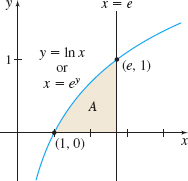EXAMPLE 7Finding the Area Under a Graph
Find the area \(A\) of the region enclosed by the graph of \(y=\ln x\), the \(x\)-axis, and the line \(x = e\).
Solution We begin by graphing \(y=\ln x\) and \(x=e\) and identifying the region whose area \(A\) we seek. See Figure 13.
Since the graph of \(y=\ln x\) forms the top border of the area \(A\), it appears that partitioning the \(x\)-axis from \(1\) to \(e\) is easier. This leads to the integral \begin{equation*} A=\int_{1}^{e}\ln x\,{\it dx} \end{equation*}
But at this place in the text, we do not have the tools to find \(\int \ln x\,{\it dx}\).
So instead, we partition the \(y\)-axis from \(0\) to \(1\). The left graph is \(y=\ln x\) or, equivalently, \(x=e^{y}\), and the right graph is \(x=e\). Then \[ A=\int_{0}^{1}( e-e^{y}) \,{\it dy}=\big[ e y-e^{y}\big] _{0}^{1}=( e-e) -( 0-1) =1\hbox{ square unit} \]
